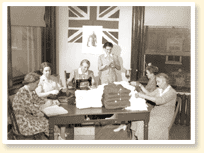

Volunteers make warm clothing to send to military personnel on the fighting front
Photo : National Film Board |
Life on the Homefront
The war coloured almost every aspect of day-to-day
life in Canada. Towns and cities bustled with activity as
factories converted to round-the-clock production of
military equipment. ( see Munitions
) New industries sprouted into
existence, as did vast air force, naval and army bases.
Streets teemed with military personnel -- not just
Canadians, but also thousands of personnel from around the world. The war was also
omnipresent in the media. Radio, movie houses,
newspapers, magazines featured constant news updates,
and advertisements from the government and citizens
groups promoting the war effort. ( see Information, Propaganda, Censorship and the
Newspapers ) Canadian seaports and coastal airports, crucial for the
shipment of North American supplies to the fighting
fronts, played a key role in the war at sea. ( see Shipping and Shipbuilding ) Enemy naval
forces came close to British Columbia, and even closer to
the Atlantic provinces and Quebec. On the east coast
scores of German submarines sank more than a hundred
ships, many within sight of shore. ( see The Battle of the Atlantic )
Lights in coastal
communities were blacked out, and volunteers trained to
assist the police, fire departments and hospitals in the
event of enemy attack. Volunteers in remote coastal areas
worked as observers for the military to warn about enemy
activity in the air and at sea. Across the country many people too young or too old,
or not physically qualified for active military service
joined student cadet and reserve military units to
carry out evening and weekend service. Most community
groups and religious faiths performed volunteer work -
knitting warm woollen clothing, collecting books and
newspapers, or baking cookies and other treats to send to
the men and women serving at the fighting fronts
( see Women and the War on the
Home Front ) These efforts reflected a personal bond between the
population and the war effort. Nearly one Canadian in
ten enlisted for full-time service in armed forces so that
almost everyone still at home had a family member or
friend in uniform. News of the hundreds or thousands of
Canadian servicepeople killed or badly injured in periods
of intense combat on the Atlantic, in Europe, and in Asia
therefore deeply touched communities across the
country.
French Articles
-
Sur le "front de l'arrière"
Le Devoir, 09/04/1940
-
Avis aux Italiens du Canada
Le Devoir, 15/06/1940
-
Ce 'blocus' postal
Le Devoir, 11/07/1940
-
Coût de la vie dans les diverses régions
Le Devoir, 06/07/1941
-
"6,653 lits de guerre au Canada"
Le Devoir, 23/07/1941
-
Les soldats tentent de briser la grève à Hamilton
Le Devoir, 29/07/1941
-
Les grèves de l'industrie de guerre
Le Devoir, 01/08/1941
-
La milice peut être employée en cas de grève
Le Devoir, 14/08/1941
-
Recherche des causes de la grève d'Arvida
Le Devoir, 26/08/1941
-
"Semaine de 'nouvelle consécration du peuple canadien à la cause démocratique contre la tyrannie naziste'"
Le Devoir, 27/08/1941
-
L'ordonnance sur le crédit au consommateur
Le Devoir, 15/10/1941
-
Le comité de la protection civile
Le Devoir, 08/01/1942
-
Une synthèse de la protection civile
Le Devoir, 08/04/1942
-
Première attaque directe contre le sol canadien
Le Devoir, 22/06/1942
-
"Nouvelles de guerre. 10,000 donneurs de sang à Québec"
Le Devoir, 17/09/1942
-
Les écoliers ne doivent pas être indifférents à l'effort de guerre
Le Devoir, 18/09/1942
-
La déclaration de guerre du Canada lie tous les citoyens
Le Devoir, 14/01/1943
-
Raid de la prévôté militaire à St-Martin et à l'Abord-à-Plouffe
Le Devoir, 03/08/1944
-
Les raids de la prévôté militaire dans Laval
Le Devoir, 07/08/1944
-
La défense civile serait réduite
Le Devoir, 19/09/1944
|